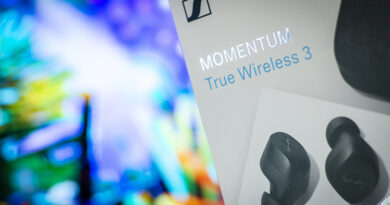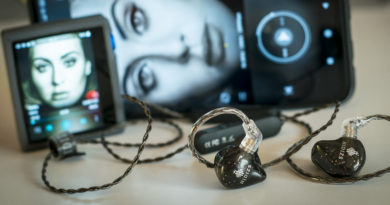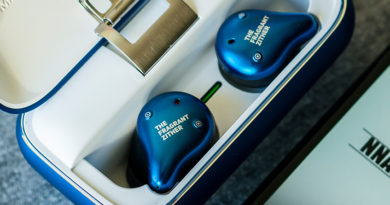FiiO UTWS3 – universal, functional and wireless


Another look at Bluetooth wireless receiver from a different perspective (means another formfactor). This market is trending and so many options are available that it is hard to make the right choice from the very first try. We’ve already been playing with TWS IEMs, Bluetooth neckband wires and standalone devices but not the “ear hook” type DAC/amps. Seen those couple of times before on sales but not from a trusted brand or a supplier. Although, such formfactor always looked promising and intrigued with the possible comfortable fit, battery capacity and max. power potential due to a larger compartments and its universality for different types of IEMs. To be honest, looking at the picture of such type of product, we are not making another idol: yes, it should be better than any other all-in-one TWS or Bluetooth receiver in certain aspects, its universality would stay limited to several IEM shapes or connection types and the product would be worthy to try only after it has passed several iterations and came to a stage of maturity…
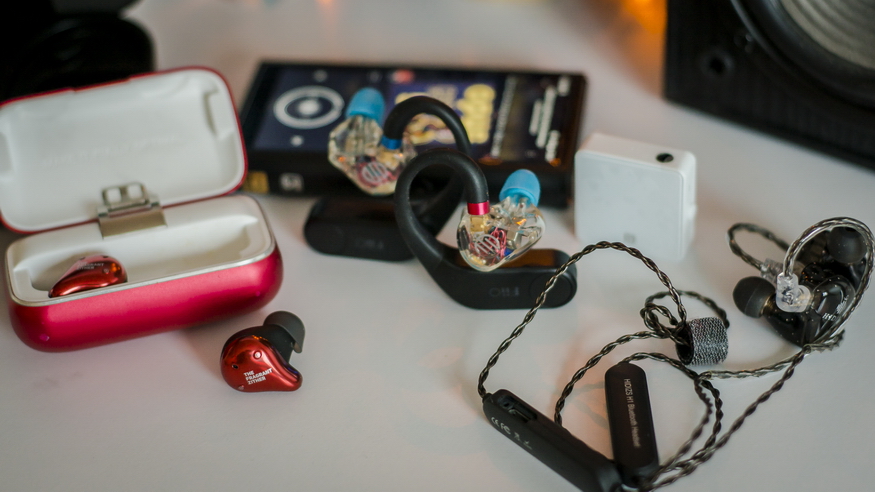
With all that in mind, FiiO UTWS3 was kind of a surprise – coming from a well-known portable audio brand, full of features and impressive specs. For us, the most important is that this product represents the next iteration with heavy upgrades to its predecessor – original FiiO UTWS (UTWS1). At least, it means heavy usage, collecting feedback, thinking over, bug fixing, improving and upgrading various aspects, both software and hardware which eventually leads to a better product with polished user experience. Whether it is that mature already? – we would tell in the conclusion. Meanwhile, here is some infromation about the company, a small flashback to FiiO UTWS history and the idea behind its new version:
First of all, about FiiO brand in short:
Guangzhou FiiO Electronics Technology Co., Ltd. was established in 2007 by several former senior staff and tech experts of OPPO, which is a high-tech enterprise focusing on researching and developing portable music products, with current main products being Hi-Res music players, headphone amplifiers&DAC, and headphones/earphones.
There are over 300 employees in total, including a core team with nearly 30 years of R&D experience in audio products, an R&D engineer crew dedicated to software, hardware, industrial design, structure and electroacoustics. The production factory covers an area of 3500 square meters, including an all-new updated dust-free workshop and 4 two-way assembling production lines, with an annual production of up to 1 million pcs.
FiiO specializes in self-research and development, and sells FiiO-branded products through sales agents worldwide which cover 5 continents spanning 65 countries and regions. Since its establishment, FiiO has built a good brand reputation in the industry. In Nov. 2017, the Headphone Branch of China Audio Industry Association was found, while FiiO was honored to join and elected to be the vice-chairman; 3 years in a row from 2017 to 2019, FiiO has been on the Top 10 HIFI Headphone and Digital Audio Brand list, as well as Chinese Top 20 Cutting-Edge IP Enterprise and Guangzhou Little Giant Enterprise of Science and Innovation; By virtue of outstanding product designs, FiiO has received 47 valid patents, including 2 invention categories, and countless well-known awards, including iF Design Award, Reddot Award, EISA Award, VGP Award, and Spring/Autumn Headphone Festival Award.
FiiO has been continuously carrying on the music proposition of “Born for Music”, placing great importance on user needs and ceaselessly pursuing perfection in product design and manufacturing, to supply users with the best audio products at the best prices.
FiiO has already been long involved into Bluetooth audio devices and released full bunch of products with different usage scenarios in mind:
- BTR series Bluetooth AMPs (for use with a smartphone, PCs, etc with the regular IEMs or headphones)
- FB1 IEMs with integrated neckband Bluetooth cable
- EH3NC Bluetooth overheads with noise cancelling feature
- TWS IEMs (popular model of the trending market)
- UTWS1 – Bluetooth ear hooks to use with any IEMs

Considering the popularity of UTWS1 (and its shortcomings on the other hand after some heavy usage) – FiiO has decided to give it a new birth when the product would be free of any previous bugs and inconvenience. Initially, UTWS1 were based on the third-party product that already had some hardware limitations in its core. Therefore, the new generation was decided to be given in-house design, research, development and production processes. The main points of concern (i.e. upgrades) during UTWS3 development were the introduction of independent amplifier, significant increase of the output power and decrease in noise floor, more convenient charging scheme and longer battery life, better noise cancelling ability, IPX4 protection, new volume and power cycle logics and dedicated control application. All of that eventually leads to much better ergonomics and user experience. As far as we are concerned, all of the known and reported issues and inconvenience of the first generation UTWS1 were addressed and claimed to be resolved.
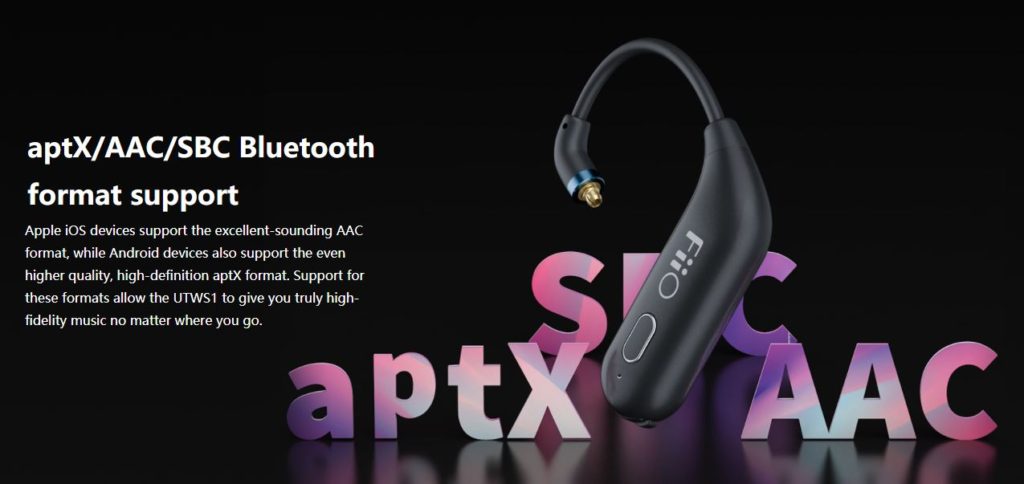
To finalize about the difference to its predecessor, here is the full list of upgrades in UTWS3:
- Now uses independent TPA6140A2 AMP
- Power output increase from 5mW to 25mW at 32Ohms
- Noise floor decrease from 25uV+ to <8uV
- No need to charge each channel with a cable, both take charge from a cradle now and charge faster
- 2nd microphone added for better noise cancelling ability
- Added IPX4 environmental protection
- Volume controls better now (26 levels, better physical buttons)
- Power ON|OFF is now controlled with cradle top cover
- Uses FiiO Control app for settings, upgrades and tuning EQ
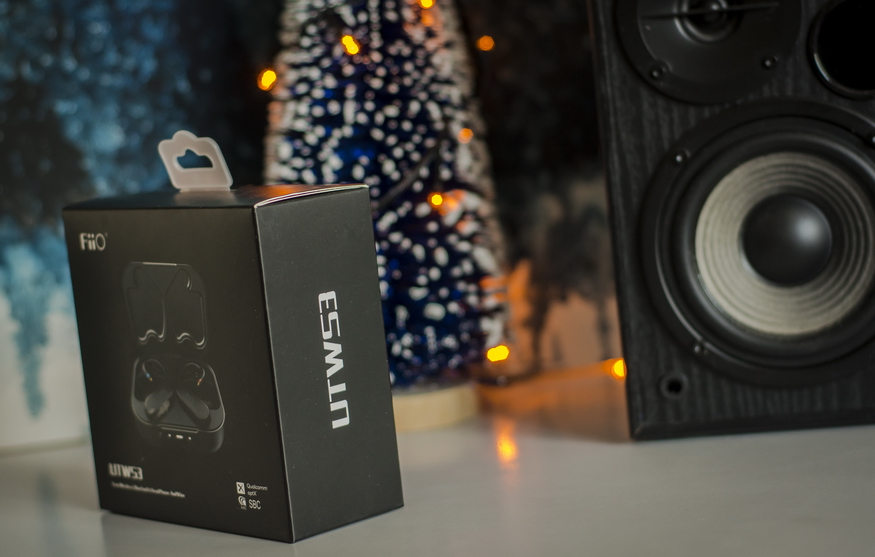
Done with the history… Let’s get back to FiiO UTWS3. The specs are as following:
- Chip: Qualcomm QCC3020, Bluetooth 5.0
- TWS+ Low Latency (2 channels connected at once)
- 2 independent amps
- Bluetooth codecs: SBC, AAC, aptX
- Output Power:
- 38mW(16Ωload)
- 25mW(32Ωload)
- Noise: <8μV
- Driving ability: 16~100Ω
- THD+N: <0.06%
- SNR: 100dB r”A“
- Output Impedance: ~0.7Ω
- Crosstalk: 94dB
- Balance: ≤0.5dB
- Working Time:
- TWS+: 7hs of use/charge
- TWS: 5.5hs of use/charge
- Overall battery life 30h (800mAh) (4-5 recharges from the case)
- Mics: 2 mics/channel with noise cancelling feature
- Device control over: FiiO Control APP
- Physical controls: multifunctional button (per each channel, on cradle)
- Indicators: multicolor LED (each channel and cradle)
- Wires: silver plated copper integrated wires
- Environmental protection: IPX4
- Connections: MMCX or 2-pin, 0.78mm
- Dimension: 93.5×71.1×34.6
- Weight: 125.5g
FiiO UTWS3 official page: LINK
FiiO UTWS3 purchase link on Amazon: LINK
FiiO UTWS3 purchase link on AliExpress: LINK
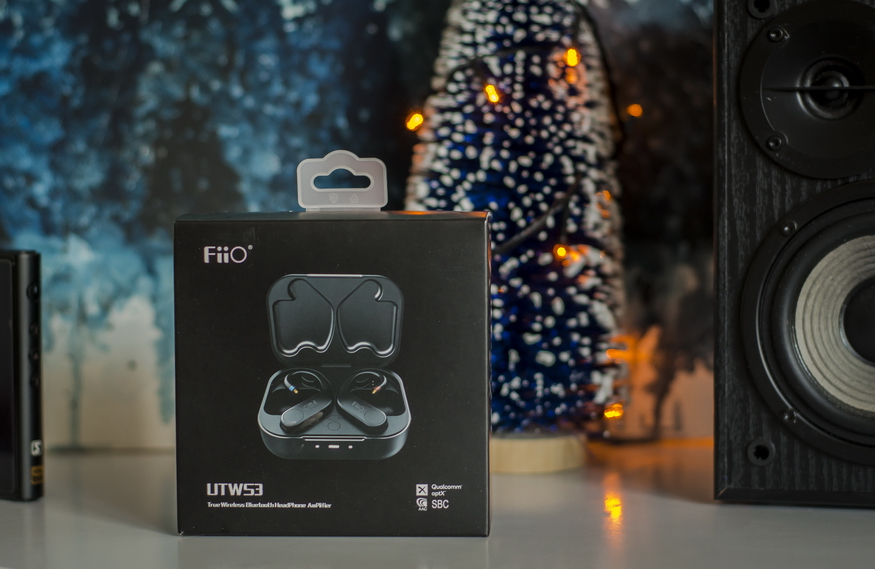
Packaging and design:
FiiO UTWS3 comes in relatively small and visually attractive box consisting of outer cover with product graphics and company information and the inner more sturdy black cardboard insert that holds the product itself. FiiO has added a special sticker on the back side of the outer cover as a solution to counterfeit item protection.
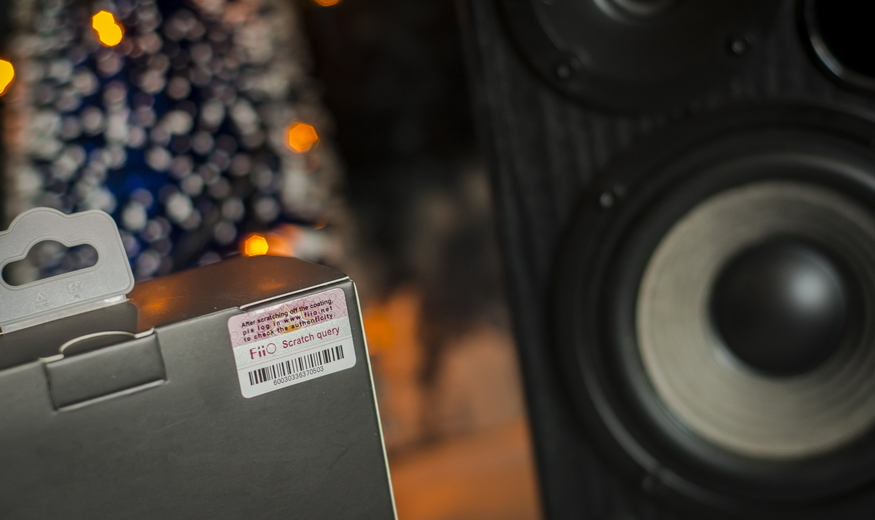
Inner box compartment has a special soft insert that holds UTWS3 cradle at place while the cable, user manual and warranty card are stored in the separate envelope underneath. Not much of the accessories, though. Only ear hooks with the cradle and charging USB type-C -> USB B cable. Wonder why FiiO has not included any carrying pouch for the sake of the product long-lasting protection.
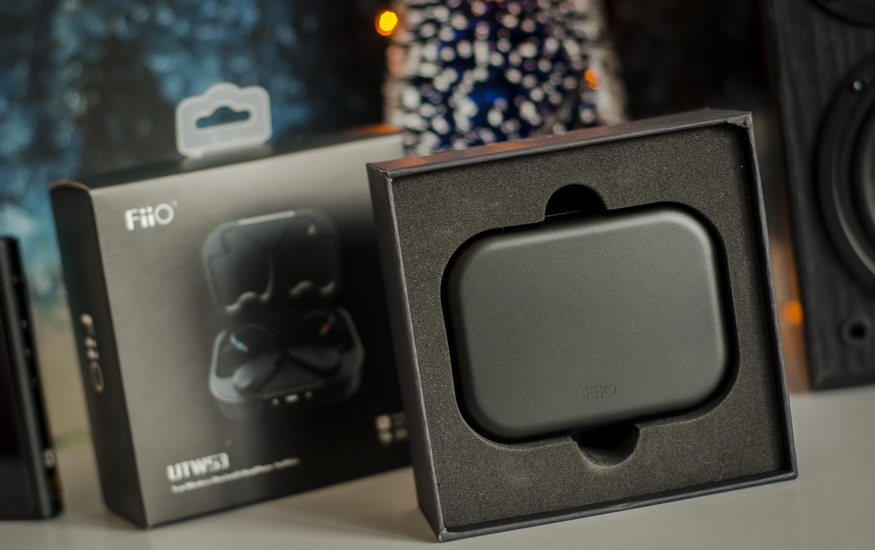
Ear hooks are stored inside the cradle and have special stickers pre-applied to charging pins in order to avoid charging during the delivery. Good way to prevent early battery deterioration before it gets to the end user. Just don’t forget to peel it off before use. Cradle, itself, makes a good impression and feel – little bit rough surface, accurate and even strict design. Someone might say that it is boring due to lack of design elements but we’d rather call it – functional. Lightweight, though, We expected its weight to be much more than it really is. There are 3 LED indicators at the facing side of the cradle and USB type-C charging port at the back. Nothing more.
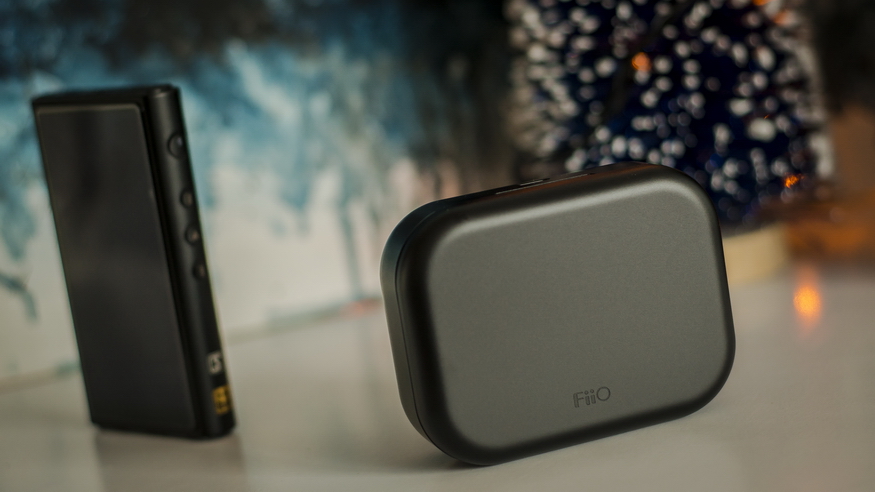
Top cradle cover opens with little effort, totally enough to keep it at place under any circumstances when the external force is not applied. Can’t tell for sure whether it is retained with a magnet but there should be some kind of element like this that enables power off|on logics for the ear hooks. Anyway, folding mechanism looks to be quite durable and feels natural.
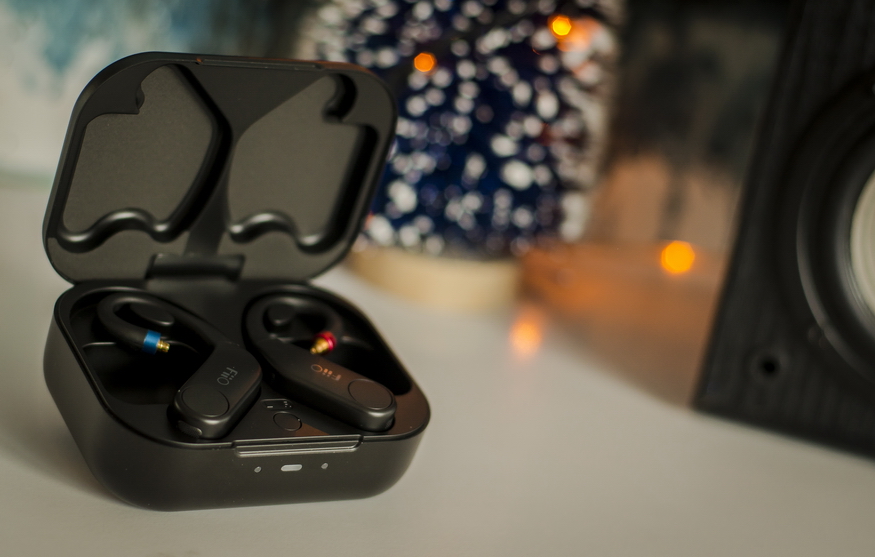
The insides of the cradle look more appealing than the externals – neat ear hook profile cutouts at the top cover and base aided by the combination of grey (scratch protection soft material adhesives) and black colors, deep lodgments designed to store third-party IEMs or earphones of virtually any size and shape. Plus the additional button at the most convenient place that does some vital tricks. Don’t worry, it won’t be used too often, only for some initial procedures.
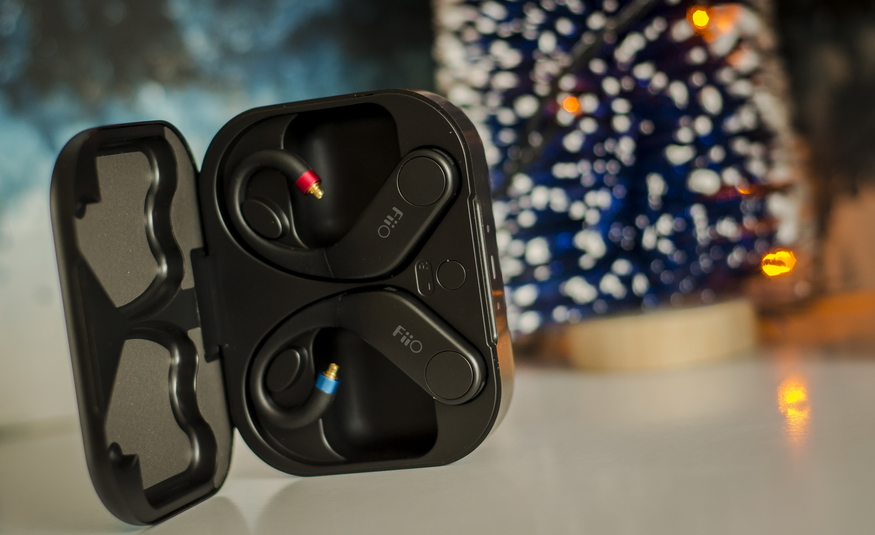
Apart of the cradle, FiiO UTWS3 ear hooks are much more sophisticated devices that contain all the magic. In terms of a design, they consist of the plastic base and flexible ear guides (perhaps, made of a silicone with inner channel for 20 strands of monocrystalline silver plated copper wire). Both channels have FiiO logos on the facing part along with large, easy to reach multifunctional button.
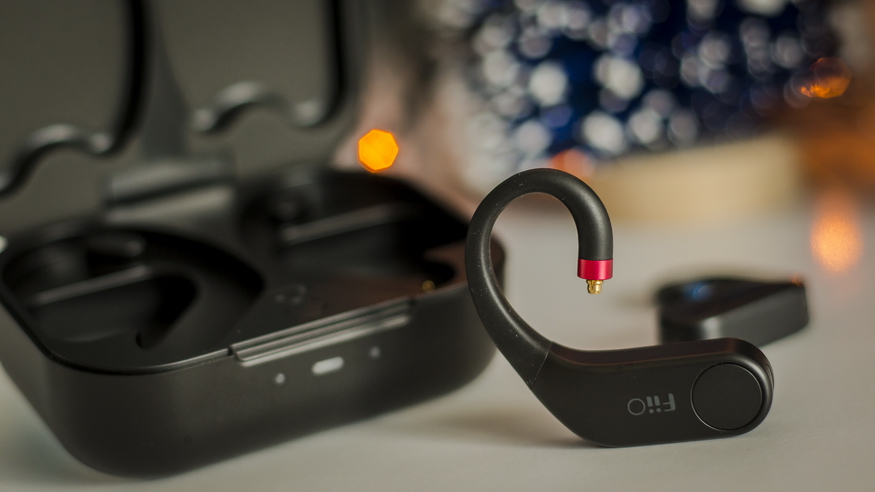
Furthermore, both channels feature 2 microphones protected by aluminum grills, white LED indicators (same opening with the backside mic), magnetic charging pins, aluminum rings acting as channel indicators (left – blue, right – red) and MMCX or 2-pin, 0.78mm connectors (both versions are available for a purchase). And the weight/channel is only 6.5g (without IEMs). Additionally, since UTWS3 features IPX4 protection, both units have special dust/moisture gaskets protecting button and mic openings.
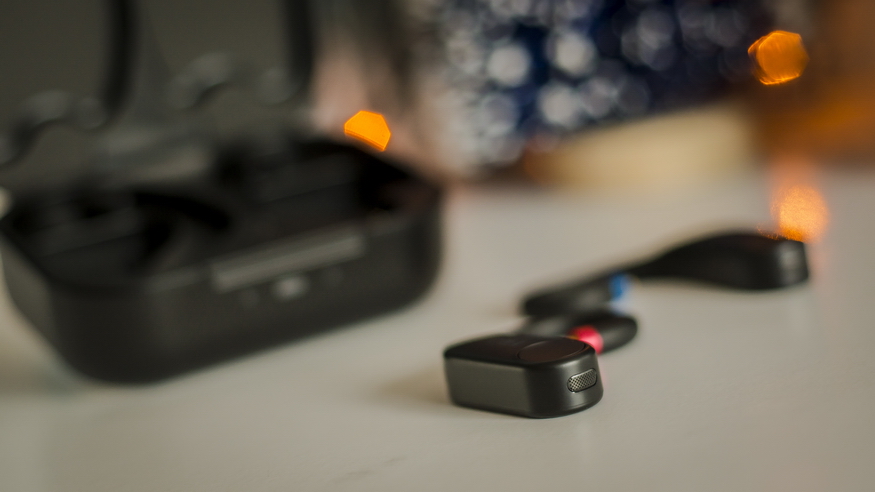
In overall, the design of the whole set is varying from strict and functional (cradle) to clean and practical (ear hooks) with only few eye-catching elements. But what is unquestionable is the precise manufacturing, perfect alignment of all elements and decent build quality.
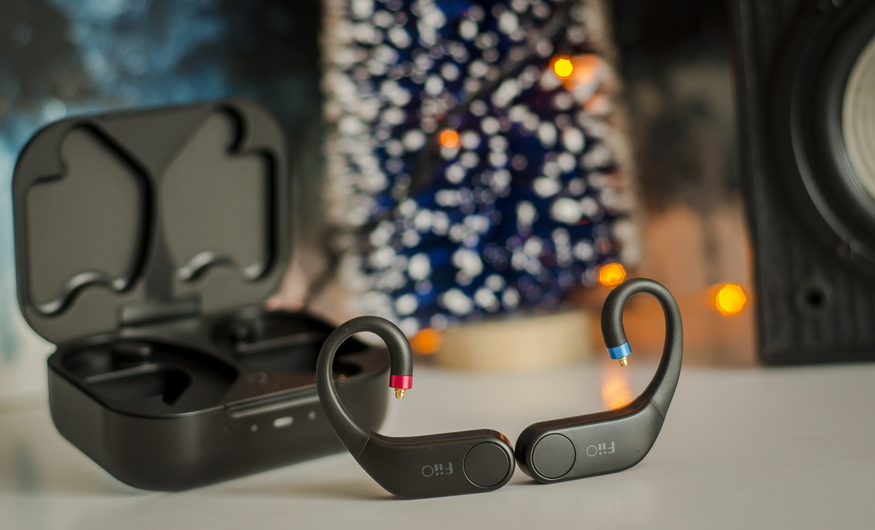
Fit:
The main point about the fit concerns the type of IEM connector selected during the purchase. MMCX type seems to be the most universal option since the connector allows IEMs to rotate over Y-axis. It gives certain freedom of adjusting the angle at which any MMCX IEMs would go into ear channel. With 2-pin option, it seems that some IEM shapes might struggle to fit into the ears correctly, especially if the output nozzles are given some irregular angle (that deviates much from 90-degrees). It is only our thought that might not be the truth. But we would really appreciate if FiiO would consider redesigning the connectors. The best option would be to have MMCX ear hooks only + the additional MMCX->2-pin, 0,78mm adapter in a bundle. Such approach would solve 2 issues: it would make UTWS3 even more universal out of the box (no need to choose and stick to connector type) and it would also allow 2-pin adapter to rotate on MMCX connection base.
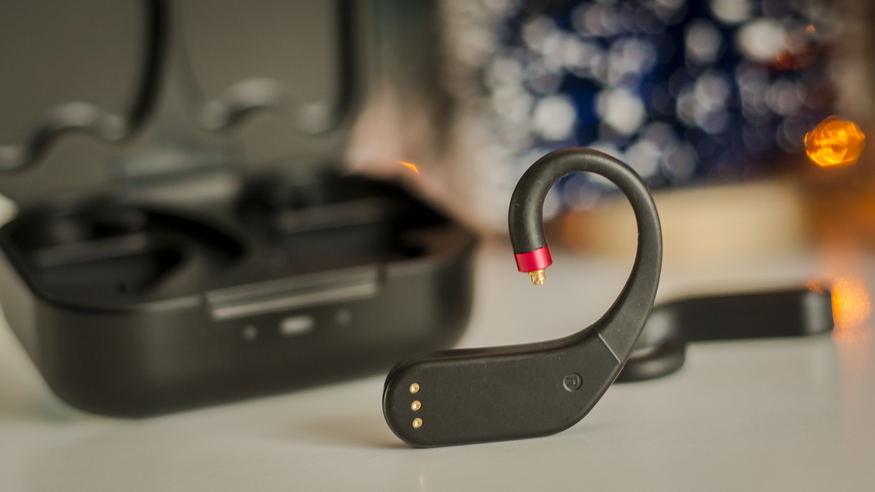
As to our version – MMCX – we have tried it with different types of IEM shapes (custom, bullet, droplet, round) – all seem to fit nicely. The least comfortable for a long ride were bullet-like shaped IEMs since the physical pressure to ear channel increases when UTWS3 ear guides flex more. This happens when IEM body is quite long, which is kind of rare. Short bullet-like IEMs as HiBy Beans, for instance, do not produce any discomfort.
One more aspect to mention in this section is the type of end gear to use in overall. FiiO UTWS3 is designed to be used on a constant basis, for music or videos, during workouts or simply to talk over the phone. The possibility to use each channel independently also makes UTWS3 a great substitute for a handsfree device. In either scenario that involves long sessions (except music or videos), full immersion with total real world isolation is not necessary and even dangerous. Outer noises should be coming in to save yourself from a possible incident, especially outside. Ok, you can use only 1 channel… But in this case, when only 1 IEM is used – you are risking to get a headache, or worse. Therefore, the best option in such usage would be to use earbuds instead of IEMs. For example, such excellent options as Ourart ACG or Ti7.
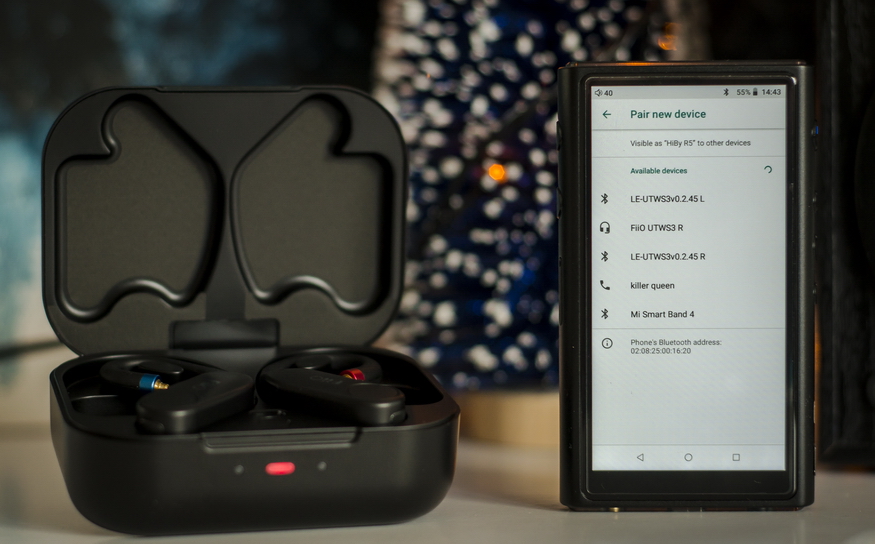
Device in use:
Since FiiO UTWS3 is quite sophisticated device it requires some learning of control operations. Initially, you would have to charge the cradle and ear hooks (inside the cradle). It takes time, but all 3 devices take charge simultaneously which is a step up from a previous version where you would have to charge each channel separately. Just wait for all 3 LEDs on the cradle to go off – it means that charging is compete. As soon as the cradle top cover is opened – both ear hooks come into life with auto power on function (power goes off when top cover gets closed) and the initial pairing process starts (center cradle LED flashes white and red). Now you can proceed with Bluetooth device discovery on your source device.
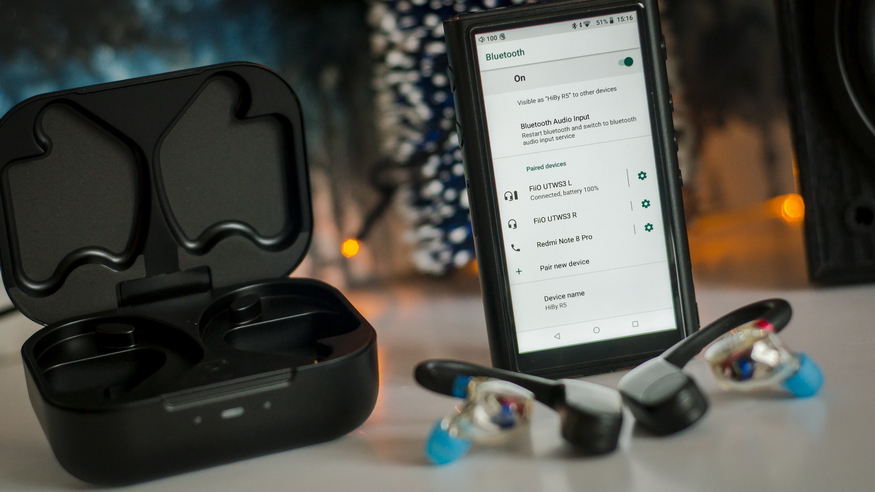
You should be able to locate FiiO UTWS3 L (or FiiO UTWS3 R or FiiO UTWS3 L/R) at this stage and connect to it, responding with “allow” whenever requested. This would result in device pairing with both channels connected at the same time. Compatible sources should report aptX as Bluetooth audio codec currently in use. FiiO UTWS3 is ready from now on. We would also recommend to get FiiO Control app from Android/iOS store to gain full control over this device. This application would allow to:
- check each channel battery state
- check and upgrade FW version
- change button functions
- set idle state power off timeout
- enable and tune EQ
- tweak audio settings and change voice language
- reset the device, clear pairing
- read user guide

By the time of writing this review FiiO has already released the new FW: 0.2.46 which has bug fixes and new volume logics listed in the changelog. The process of upgrading requires that only one channel should be upgraded at at time – means, the second channel should be in OFF state. It takes about 2-3 minutes/channel to upgrade and can be performed with OTA or local FW *.bin file. Further pairing reset and reconnect is also mandatory. Done in the following steps:
- Place both channels in cradle
- Press and hold button on cradle for 12 seconds to reset and power off
- Ear hooks would get back to life automatically in couple of seconds and synchronize to each other
- Now it is possible to connect again

Other cradle button functions:
- Long press for 3 seconds – enter pairing mode
- Long press for 12 seconds – reset pairing
- Short press – remaining battery in cradle
Indications:
- R and L white LED pulses – ear hooks charging (for 15 seconds with no USB power supply, constantly – with USB power supply)
- R and L white LED pulses go OFF – ear hooks charged
- Central white LED ON for 5 sec after opening top cover of pressing button – cradle remaining battery >20%
- Central red LED ON for 5 sec after opening top cover of pressing button – cradle remaining battery <20%
- Central white LED pulses – cradle takes charge
- Central white LED ON – cradle fully charged
- Central LED pulses white and red – ear hooks pairing in process when in cradle
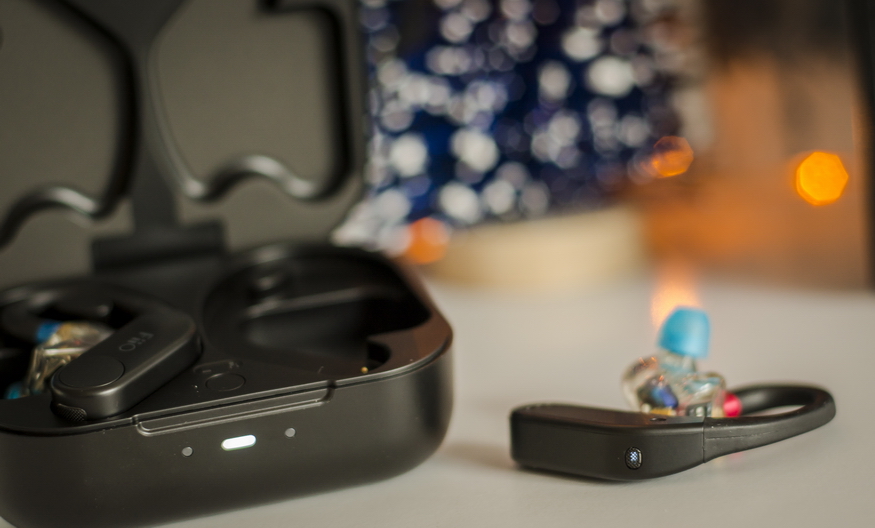
Left ear hook button:
- Single click:
- Resume playback
- Decrease volume
- Answer call
- Double click:
- Pause
- Triple click:
- Activate voice assistant
- Long press:
- Previous track
- Hang up
- Decline a call
Right ear hook button:
- Single click:
- Resume playback
- Increase volume
- Answer call
- Double click:
- Pause
- Triple click:
- Activate voice assistant
- Long press:
- Next track
- Hang up
- Decline a call
For both channels when not in cradle:
- In OFF state – press for 1 second to power ON
- In On state – press for 5 seconds to power OFF
Huh… Requires some time to memorize…
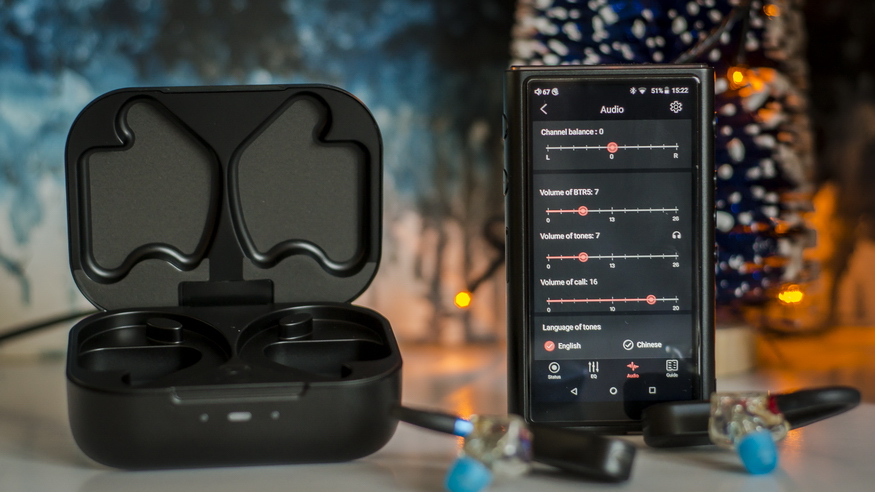
As stated in the description, full charge would allow to use each channel for ~5.5 – 7 hours (which is close to real world figures) and the cradle would also allow to fully charge both channels for 5 times.
No problems were met during pairing process, real world usage, charging or upgrading the firmware. FiiO UTWS3 declared functionality seems to be fully implemented and thoroughly polished. Phone calls don’t disappoint either, providing good voice quality and smplartphone-level noise cancelling performance. Buttons do the job as expected and defined above.
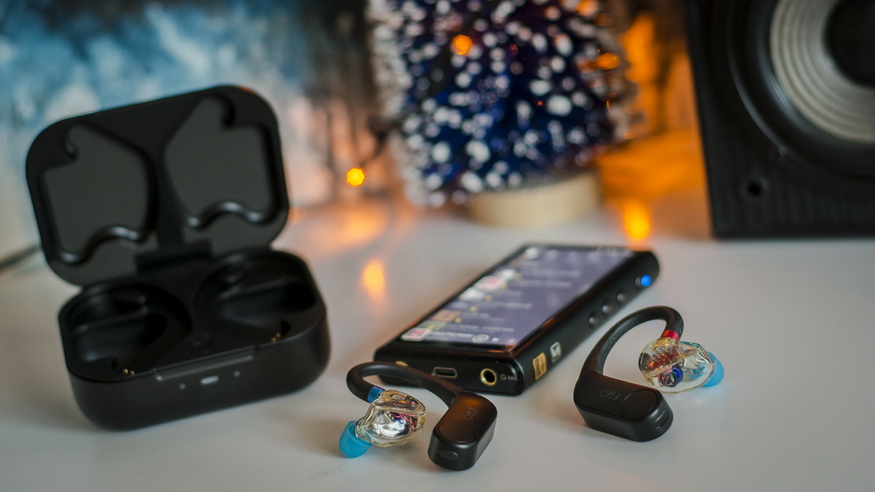
Sound quality:
Now, to the most interesting part. Our testing setup would be HiBy R5 Sabre DAP + FiiO UTWS3 + ArtMagic DH3 (15Ohms) IEMs and aptX codec. We would leave out examining sound with SBC or AAC as less capable codecs, not worth of attention if you have already spent more than $500 for the entire setup. Qualcomm QCC3020 chip over AptX, at least, gives you 16bit/48kHz at 384 kbit/s and frequency response 20Hz – 22.7kHz. More than CD quality but not HD yet.
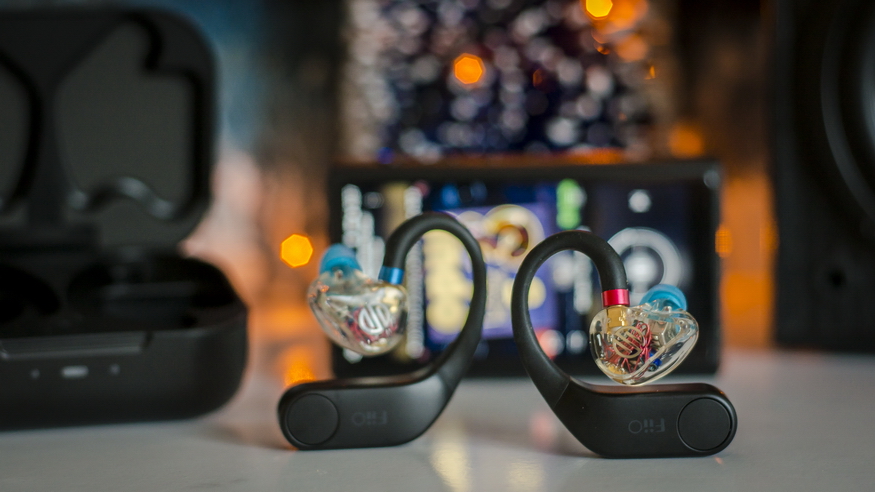
DH3 are hybrid, easy to drive IEMs with only 15Ohms impedance and 105dB sensitivity. It results in ~55mW of power from UTWS3 which is more than enough to squeeze out the appropriate dynamics and volume level. Such IEMs would get very loud, almost unbearable. Anything sensitive up to 50Ohms should be driven adequately.
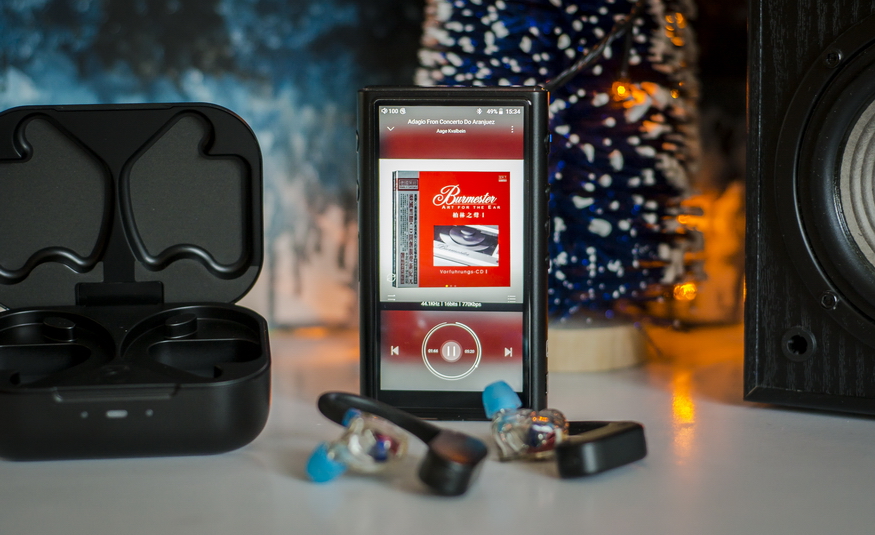
Since UTWS3 feels quite linear in tuning, there won’t be any accents on either range other than IEMs would produce on its own. In comparison to cable connection, a certain model of IEMs would sound quite similar, with slightly less clarity on treble, slight decrease in overall resolution and texturing. First addresses Bluetooth codec potential that usually strikes the highest octaves, while the resolution suffers from the limited potential of hardware processing packed to a single chip with significantly reduced element base. But this is only in comparison to HiRes DAP as a source. If to compare UTWS3 to a regular smartphone output sound – some of its aspects would even get improved. For example – midbass dynamics.
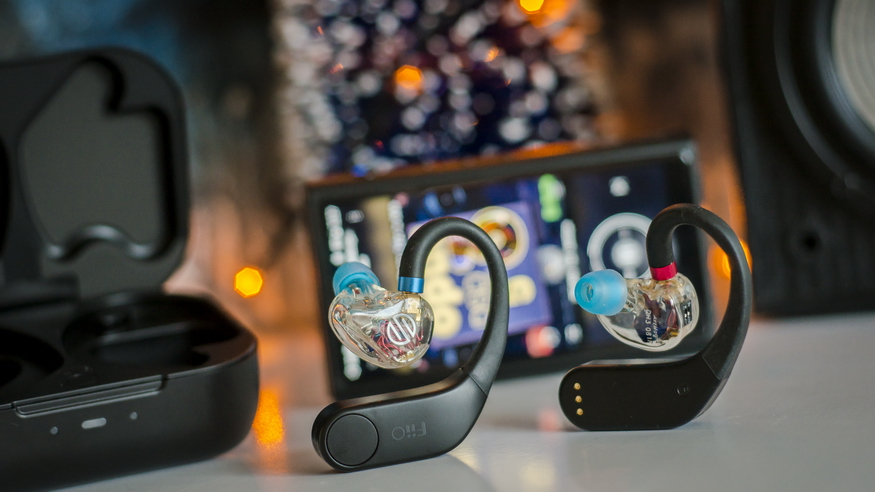
In overall, UTWS3 lows feel quite collected and contoured rather than deep or extended, midbass has appealing dynamics and power, mids are linear, with moderate resolution and good balance between male and female vocals, lower treble feels calm and delicate while the extension is slightly below the average. We wouldn’t insist that UTWS3 is capable to substitute wire for a quality-aware listener, neither we would say that UTWS3 cannot substitute wire when necessary for any audio fan. Since it doesn’t add any coloration to regular sound of your favorite IEMs or earbuds – it is a good option whenever wires limit your mobility.
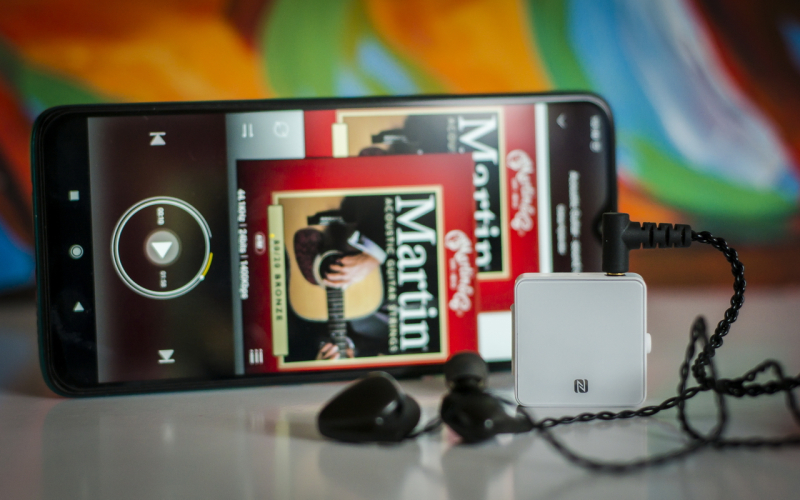
Compared to Hidizs H2: completely different formfactor, still portable, much more capable in terms of Bluetooth codecs (aptX HD, LDAC, UAT) but at the same time – more limited in power output and more susceptible to audio lag. Yes, Hidizs H2 has its numerous strong points but FiiO UTWS3 are far better if the usage scenario is portable everyday use. Especially with a smartphone, when you want to answer calls. Sound-wise, both are neutral sources for IEMs and both behave quite similar. H2, of course, has more potential due to HD codecs but cannot drive similar loads as FiiO UTWS3 do.
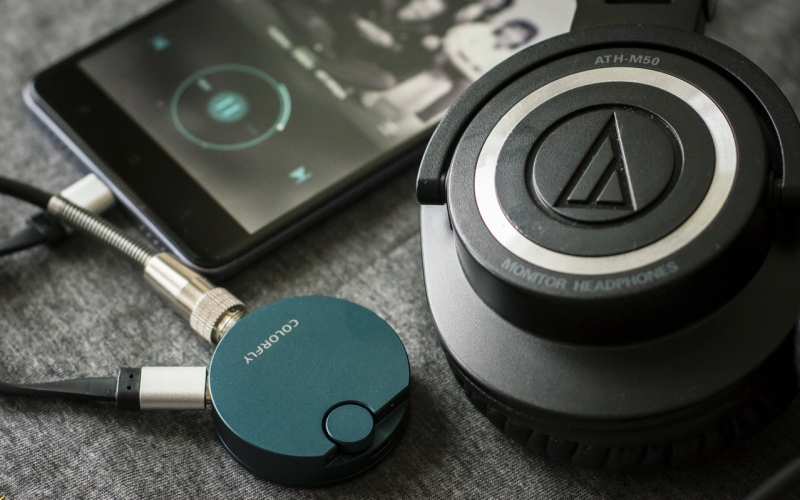
Compared to ColorFly BT-C1: almost similar to Hidizs H2, ColorFly represents a standalone product with less portability in mind. It is a closer match to UTWS3 due to only aptX codec support and same power output level. It is very neutral, if not to say boring. Mostly designed to be used as a shelf receiver for active speakers. Not a contender for its planned way if use and less appealing tuning.
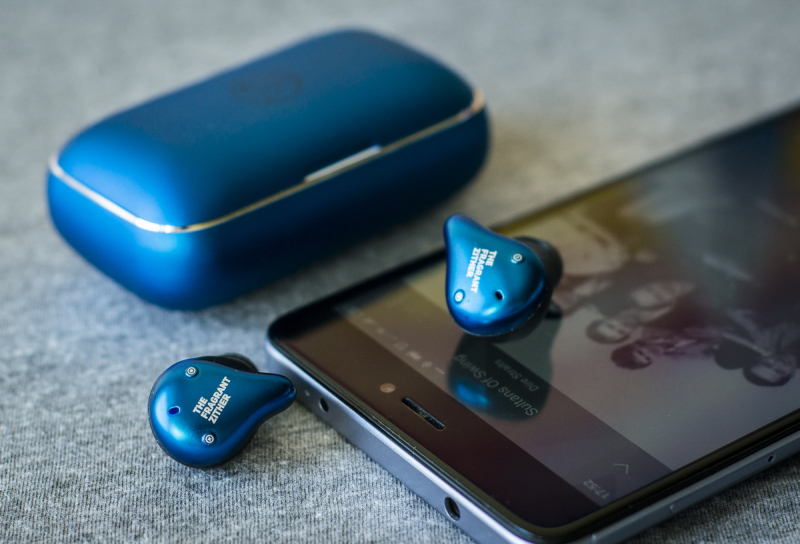
Compared to TFZ X1: perhaps the closest match of those, but in a formfactor of IEMs with inbuilt Bluetooth receiver. Less universal, limited to only 1 sound character, less sophisticated in terms of functions and much worse during the phone calls. Overall user experience of TFZ X1 is far from ideal – buttons are too small, LEDs are almost invisible, noise cancelling not good. But the build quality is decent, aptX is supported and sound is quite impressive. FiiO UTWS3 definitely wins, thanks to the possibility of connecting different IEMs.
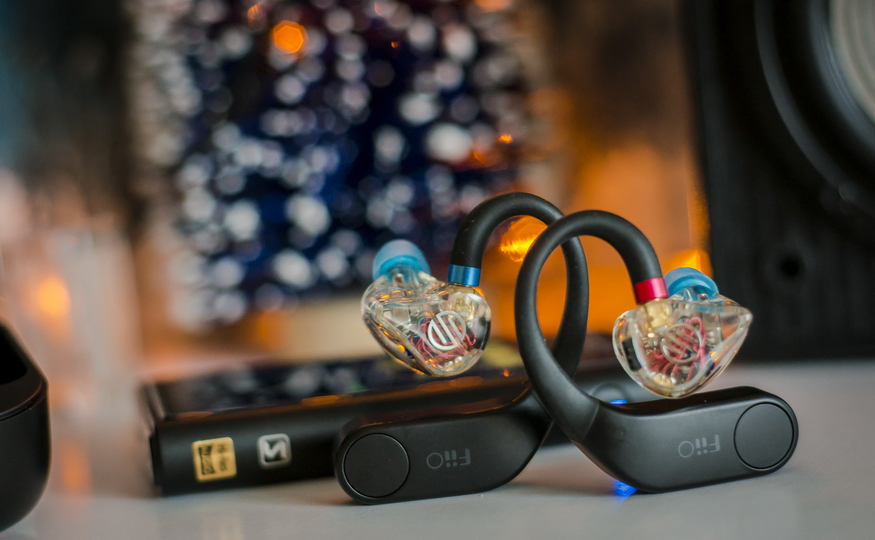
Conclusion:
Perhaps, FiiO UTWS3 is currently the best representative of what Bluetooth TWS product should be like. Polished in a second iteration, free of bugs or limitations, with adequate revised logics – this product provides strong user experience and stellar performance in the most universal formfactor. Neckbands, TWS IEMs, standalone receivers – all would be less capable or portable in everyday use, either not allowing to switch end gear or to perform routine activities in the most convenient way. FiiO UTWS3, with the idea of universal wireless receiver for any IEMs or earbuds, does the trick in a best possible way, providing audio fans with enough quality and regular user with the appropriate level of comfort and functionality. Or the mixture of those, as the most valuable result. We would definitely stick to this product for a long period as the most universal option currently available on the market…
FiiO UTWS3 official page: LINK
FiiO UTWS3 purchase link on Amazon: LINK
FiiO UTWS3 purchase link on AliExpress: LINK


